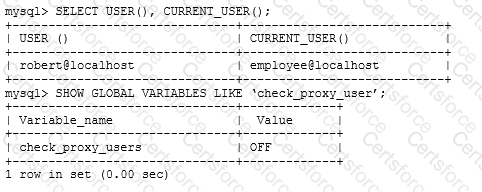You are contacted by a user who does not have permission to access a database table. You determine after investigation that this user should be permitted to have access and so you execute a GRANT statement to enable the user to access the table.
Which statement describes the activation of that access for the user?
The ‘applicationdb’ is using InnoDB and consuming a large amount of file system space. You have a /backup partition available on NFS where backups are stored.
You investigate and gather this information:

Three tables are stored in the InnoDB shared tablespace and the details are as follows:
The table data_current has 1,000,000 rows.
The table data_reports has 1,500,000 rows.
The table data_archive has 4,500,000 rows.

You attempt to free space from ibdata1 by taking a mysqldump of the data_archive table and storing it on your backup partition.

Unfortunately, this action does not free any actual disk space back to the file system and the server disk space is running out.
Which set of actions will allow you to free disk space back to the file system?
What are three methods to reduce MySQL server exposure to remote connections? (Choose three.)
Consider the key buffer in a MySQL server. Which two statements are true about this feature? (Choose two.)
You are no longer able to log in to an existing MySQL Server because the root password credentials not working. You need to reset the root password to complete various administrative tasks. What are the two major methods that will achieve this? (Choose two.)
These details are shown when logged in to an account:

Which set of statements would match the accounts shown?
Where does MySQL Linux RPM install the mysqld binary?
You have a consistent InnoDB backup created with mysqldump, the largest table is 50 GB in size.
You start to restore your backup with this command;
shell> mysql –u root –p < backup.sql
After 30 minutes, you notice that the rate of restore seems to have slowed down. No other processes or external factors are affecting server performance.
Which is the most likely explanation for this slowdown?
An existing master-slave setup is currently using a delayed replication of one hour. The master has crashed and the slave must be “rolled forward” to provide all the latest data.
The SHOW SLAVE STATUS indicates these values:
RELAY_LOG_FILE=hostname-relay-bin.00004
RELAY_LOG_POS=1383
Which command set would make the slave current?
Which are three facts about backups with mysqldump? (Choose three.)